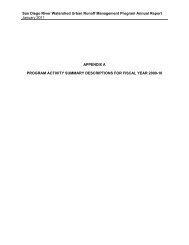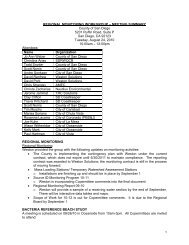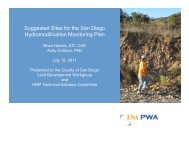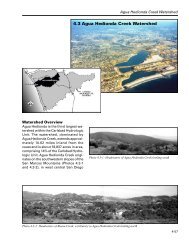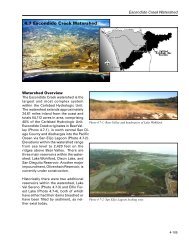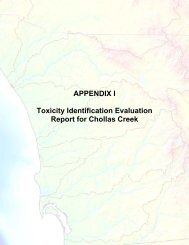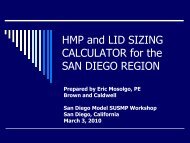APPENDIX I Toxicity Identification Evaluation Reports for Chollas ...
APPENDIX I Toxicity Identification Evaluation Reports for Chollas ...
APPENDIX I Toxicity Identification Evaluation Reports for Chollas ...
You also want an ePaper? Increase the reach of your titles
YUMPU automatically turns print PDFs into web optimized ePapers that Google loves.
<strong>Toxicity</strong> <strong>Identification</strong> <strong>Evaluation</strong> of <strong>Chollas</strong> Creek<br />
Stormwater using Hyalella azteca<br />
Results<br />
August 2006<br />
The 0.025 mg/L PBO treatment increased toxicity in the 100 percent sample concentration (0%<br />
survival) relative to toxicity in the unmanipulated Baseline test (80% survival in the 100 percent<br />
sample concentration). The NOEC was less than 50%, and the LC 50 was 32.5%. Survival in<br />
the 0.025 mg/L PBO treatment blank was 86.7%. The 0.050 mg/L PBO treatment also<br />
increased toxicity in the 100 percent sample concentration (20% survival) relative to toxicity in<br />
the unmanipulated Baseline test (80% survival in the 100 percent sample concentration). The<br />
NOEC was less than 50%, and the LC 50 was 27.27%. Survival in the 0.050 mg/L PBO<br />
treatment blank was 80 percent. The increase of toxicity in these manipulations suggests that<br />
pyrethroids may be a causative agent in this stormwater sample. Specifically, it is well-known<br />
that sublethal concentrations of PBO potentiate the toxicity of pyrethroids (Budavari, 1989).<br />
A copper sulfate reference toxicant was tested at nominal concentrations of 62.5, 125, 250, 500<br />
and 1000 µg Cu 2+ /L. The calculated 96-hour LC 50 (189.41 µg Cu 2+ /L) was within two standard<br />
deviations of the laboratory mean (365.19 µg Cu 2+ /L) at the time of testing. This indicates that<br />
the sensitivity of H. azteca used in this evaluation fell within the normal range.<br />
Survival of H. azteca in three of the treatment blanks (Aeration, Filtration, and Methanol Elution<br />
tests) was lower than expected. While reference toxicant tests demonstrated adequate<br />
sensitivity of these test organisms, these tests use a higher volume of water (200 mL) than in<br />
the TIE tests (50 mL), which likely is preferred by these test organisms. It is also possible that<br />
test organisms used in the October TIE tests were more sensitive. More specifically, lower<br />
tolerance to test conditions and lower survival in three of the treatment blanks may be related to<br />
the source and age of the test organisms. Due to the last second nature of the October<br />
stormwater sampling event, there was not sufficient time as to allow <strong>for</strong> the ordering of test<br />
organisms from the standard source (i.e. Aquatic Indicators). Thus the organisms used in the<br />
October TIE were those cultured according to standard protocols at Weston. As a result, slight<br />
differences in age and source of organisms may explain the low tolerance to TIE test conditions,<br />
and slightly reduced survival in the three treatment blanks.<br />
4.1.2 Summary of TIE Per<strong>for</strong>med on the October 18, 2005 Stormwater Sample<br />
The results from the Phase I TIE per<strong>for</strong>med on the <strong>Chollas</strong> Creek stormwater sample collected<br />
in October indicated that pyrethroids may be the cause of the toxicity observed in the initial<br />
toxicity tests. First, in the Baseline test, toxicity of H. azteca exposed to diluted and undiluted<br />
stormwater (80 to 100% survival) was significantly lower than that in the initial toxicity test (7.5<br />
to 42.5% survival). This indicates that during the time elapsed between the initial and baseline<br />
toxicity tests, the causative agent in the stormwater sample had degraded, or had significantly<br />
adsorbed to the plastic container in which the sample was held. Pyrethroids are known to<br />
adsorb to plastic, thus leading to a time-dependent reduction in toxicity (Wheelock et al., 2005).<br />
Second, the lack of toxicity reduction in the EDTA, STS, graduated pH, and aeration treatments<br />
indicates that the causative agent was likely not a metal, an oxidative chemical, a pH-sensitive<br />
chemical, or a volatile chemical or surfactant, respectively. However, the reduction in toxicity of<br />
H. azteca following filtration of the stormwater sample indicates that the causative agent was<br />
highly bound to particulates in the sample. Pyrethroids have physicochemical properties that<br />
match the results of the present TIE; pyrethroids are insoluble in water but soluble in solvents<br />
(have high K ow s), have low vapor pressures (indicating low volatility), and have high adsorption<br />
coefficients, indicating their tendency to adsorb to particulates (Kidd and James, 1991). In<br />
addition, toxicity was significantly increased in the diluted and undiluted PBO-treated stormwater<br />
samples, as compared to toxicity in the baseline test (untreated diluted and undiluted<br />
stormwater). These results also indicate pyrethroids as the causative agents because pyrethroid<br />
toxicity is potentiated by PBO (Budavari, 1989).<br />
Weston Solutions, Inc. 16







